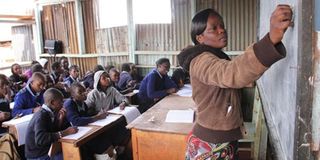Poorest KCPE composition got 4 marks

A lesson in progress at St Juliet Education Centre in Kisumu Ndogo, Kibera, Nairobi, on May 7, 2015. FILE PHOTO | JEFF ANGOTE |
What you need to know:
- Script, which does not show story development and flow of thought, is also poor and incoherent.
- Report wants teachers to complete syllabus to spare candidates the agony of having to guess.
The poorest composition in last year’s Kenya Certificate of Primary Education examination scored a dismal four marks out of a possible 40.
Even though this is an improvement over the previous year, when the poorest candidate scored two marks, still, this is nothing to write home about, really.
While candidates were required to write a grammatically accurate, fluent, interesting, original and convincing story based on a few sentences provided as a guide, all that this candidate wrote was to “shape letters correctly’” according to the examiner’s comments.
The examiner also said the candidate was able to spell simple words, including “can”, “near” and “good”, correctly. Also, the student had some concept of indenting paragraphs.
The revelation is contained in the latest Kenya National Examinations Council report, which samples some of the candidates who can hardly communicate in writing in English Composition or Kiswahili Insha.
The report shows a continuing inability by Standard Eight candidates to write tests, a trend that is worrying educators.
Reading through the composition, you realise there is no story development, and the flow of thought is also poor and incoherent.
Another candidate, who managed only six marks, had severe linguistic limitations that completely hampered the ability to communicate, according to the examiner’s comments
“Also, the student had gross errors of spelling,” the report says. Such words, which are misspelt include ‘futbboll’, ‘becous’ and ‘whay’
The postmortem is meant to help teachers and candidates prepare better for future examinations.
LINGUISTIC MATURITY
The best written composition earned the candidate 38 marks out of 40, having done almost all that the examiner wanted.
“The script gives evidence of linguistic maturity and good planning. Sentences are well-constructed, punctuations are well used, vocabulary is apt and one cannot fail to notice the good handwriting,” the report says of the best composition.
In mathematics, most candidates had challenges answering questions on algebra and measurement.
Also questions on calendar, properties of parallel lines and travel graphs proved a hard nut to crack for most pupils, according to the report.
“These are areas that need the attention of both the pupils and teachers,” the report adds.
The examiner noted that girls continued to struggle in the sciences last year.
“Teachers must strive to bridge the gap by using approaches that motivate female pupils towards science subjects from an early stage so that the poor show is not transferred to the next level of learning,” the report adds.
At the same time, the examinations council wants schools to ensure they complete the syllabus. “Failure to cover the syllabus persuades candidates to guess,” adds the report.
Teachers should also set revision questions for their candidates instead of buying examination papers set by teachers from other schools.





